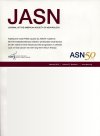ATP-Gated P2X7-Ion Channel on Kidney-Resident Natural Killer T Cells and Memory T Cells in Intrarenal Inflammation
Parenchymal T cells in the kidney expressed much higher levels of P2X7 than vascular T cells.P2X7-blocking nanobodies uncover a large fraction of kidney-resident natural killer T and tissue-resident memory T cells.These cells were lost during cell preparation because of activation of P2X7 by NAD+ released from damaged cells, unless blocked by nanobodies.
Background
The P2X7 ion channel, a key sensor of sterile inflammation, has been implicated as a therapeutic target in GN, and P2X7-antagonistic nanobodies can attenuate experimental GN. However, little is known about the expression of P2X7 on renal immune cells.
Methods
We used conventional immunofluorescence of kidney sections and intraperitoneal injection of nanobodies in mice followed by flow cytometry analysis of parenchymal T cells and RNA sequencing to elucidate the expression and function of P2X7 on parenchymal and vascular immune cells in the mouse kidney.
Results
Our study showed that parenchymal T cells, including a large subset of natural killer T cells and CD69+ tissue-resident memory T cells, display much higher cell surface levels of P2X7 than vascular T cells. After a single intraperitoneal injection of P2X7-blocking nanobodies, P2X7 on parenchymal T cells was fully occupied by the injected nanobodies within 30 minutes. This resulted in an effective protection of these cells from nicotinamide adenine dinucleotide–induced cell death during cell preparation. Conversely, systemic injection of nicotinamide adenine dinucleotide that mimics sterile inflammation results in the selective depletion of P2X7hiCD69hi T cells from the kidney parenchyma.
Conclusions
Our study uncovered a novel purinergic regulatory mechanism affecting kidney-resident T-cell populations.




